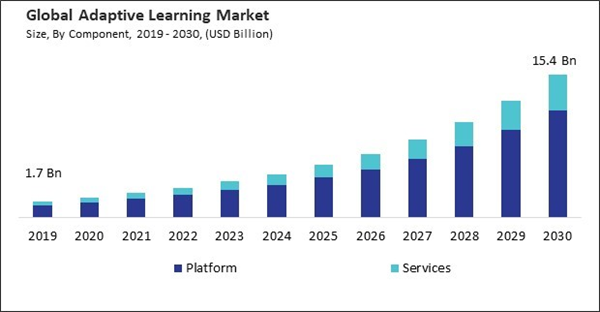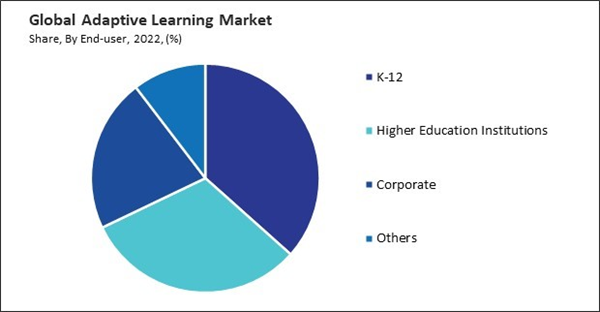The Global Adaptive Learning Market size is expected to reach $15.4 billion by 2030, rising at a market growth of 21.8% CAGR during the forecast period.
The European education sector has been emphasizing personalized and learner-centric approaches. This form of learning, with its ability to tailor educational content to individual student needs, aligns well with the demand for personalized learning experiences. Consequently, the European region would acquire nearly, 28% of the total market share by 2030. The growth of online and blended learning models in Europe has driven the demand for these learning solutions. The flexibility offered by adaptive platforms complements the diverse learning modes adopted by educational institutions across the continent. Thus, there will be increased growth in the segment.
These learning systems leverage technology, often artificial intelligence and machine learning algorithms, to analyze individual student performance and adapt the content accordingly. This individualization ensures that students’ progress through the material at their own pace. Moreover, systems consider the diverse ways in which students learn. They can adapt not only to the pace of learning but also to the preferred learning style of each student. Some students may benefit more from visual aids, while others prefer text-based content or interactive simulations. These aspects will lead to increased growth in the market. Additionally, online education, facilitated by these platforms, allows students to access educational content anywhere with an Internet connection. This level of accessibility is particularly beneficial for individuals who may have geographical constraints, work commitments, or other responsibilities that make traditional education less feasible. Moreover, online education, powered by this form of learning, offers scalability, allowing educational institutions to reach a broader audience without physical infrastructure limitations. Thus, these aspects will lead to a rise in demand for this form of learning learning in the upcoming years.
However, Educational institutions often have established practices, curricula, and teaching methods. Introducing systems requires a significant shift in mindset and approach. Resistance to change can come from educators, administrators, and even students who may be accustomed to traditional teaching methods. Moreover, adopting systems involves a substantial financial investment. Educational institutions need to allocate funds for purchasing the technology, implementing the infrastructure, and maintaining the systems. This financial commitment can be a barrier, especially for institutions with limited budgets. Thus, these aspects will lead to reduced demand for this form of learning in the future.
The European education sector has been emphasizing personalized and learner-centric approaches. This form of learning, with its ability to tailor educational content to individual student needs, aligns well with the demand for personalized learning experiences. Consequently, the European region would acquire nearly, 28% of the total market share by 2030. The growth of online and blended learning models in Europe has driven the demand for these learning solutions. The flexibility offered by adaptive platforms complements the diverse learning modes adopted by educational institutions across the continent. Thus, there will be increased growth in the segment.
These learning systems leverage technology, often artificial intelligence and machine learning algorithms, to analyze individual student performance and adapt the content accordingly. This individualization ensures that students’ progress through the material at their own pace. Moreover, systems consider the diverse ways in which students learn. They can adapt not only to the pace of learning but also to the preferred learning style of each student. Some students may benefit more from visual aids, while others prefer text-based content or interactive simulations. These aspects will lead to increased growth in the market. Additionally, online education, facilitated by these platforms, allows students to access educational content anywhere with an Internet connection. This level of accessibility is particularly beneficial for individuals who may have geographical constraints, work commitments, or other responsibilities that make traditional education less feasible. Moreover, online education, powered by this form of learning, offers scalability, allowing educational institutions to reach a broader audience without physical infrastructure limitations. Thus, these aspects will lead to a rise in demand for this form of learning learning in the upcoming years.
However, Educational institutions often have established practices, curricula, and teaching methods. Introducing systems requires a significant shift in mindset and approach. Resistance to change can come from educators, administrators, and even students who may be accustomed to traditional teaching methods. Moreover, adopting systems involves a substantial financial investment. Educational institutions need to allocate funds for purchasing the technology, implementing the infrastructure, and maintaining the systems. This financial commitment can be a barrier, especially for institutions with limited budgets. Thus, these aspects will lead to reduced demand for this form of learning in the future.
By End-User Analysis
On the basis of end-user, the market is divided into K-12, higher education institutions, corporate, and others. In 2022, the higher education institutions segment witnessed a substantial revenue share in the market. Higher education institutions are increasingly recognizing the value of personalized learning experiences. These learning platforms offer a tailored approach, adjusting content, pace, and assessments to individual student needs. This personalization enhances the learning experience and addresses diverse learning styles in higher education. These aspects will pose lucrative growth prospects for the segment.By Component Analysis
Based on component, the market is segmented into platform and services. In 2022, the services segment garnered a significant revenue share in the market. Educational institutions often require assistance implementing and integrating these learning solutions into their infrastructure. Service providers offer support in setting up the learning platform, integrating it with learning management systems (LMS), and ensuring a seamless transition for educators and students. These factors will boost the demand in the segment.By Regional Analysis
By region, the market is segmented into North America, Europe, Asia Pacific, and LAMEA. The North America segment procured the highest revenue share in the market in 2022. The education sector in North America has been witnessing a growing demand for personalized learning experiences. These learning platforms, with their ability to tailor content to individual student needs, align well with the preferences of educators, students, and parents seeking customized educational approaches. These factors will boost the demand in the segment.List of Key Companies Profiled
- Pearson PLC
- McGraw Hill LLC (Platinum Equity Advisors, LLC)
- Curriculum Associates, LLC
- Imagination Station, Inc.
- Learning Explorer, Inc.
- Imagine Learning LLC (Weld North Education LLC)
- Fulcrum Labs, Inc.
- John Wiley & Sons, Inc.
- Houghton Mifflin Harcourt Publishing Company (Veritas Capital)
- CCKF, Inc. (Realizeit)
Market Report Segmentation
By Component- Platform
- Services
- K-12
- Higher Education Institutions
- Corporate
- Others
- North America
- US
- Canada
- Mexico
- Rest of North America
- Europe
- Germany
- UK
- France
- Russia
- Spain
- Italy
- Rest of Europe
- Asia Pacific
- China
- Japan
- India
- South Korea
- Singapore
- Malaysia
- Rest of Asia Pacific
- LAMEA
- Brazil
- Argentina
- UAE
- Saudi Arabia
- South Africa
- Nigeria
- Rest of LAMEA
Table of Contents
Chapter 1. Market Scope & Methodology
Chapter 2. Market at a Glance
Chapter 3. Market Overview
Chapter 4. Global Adaptive Learning Market by Component
Chapter 5. Global Adaptive Learning Market by End-user
Chapter 6. Global Adaptive Learning Market by Region
Chapter 7. Company Profiles
Companies Mentioned
- Pearson PLC
- McGraw Hill LLC (Platinum Equity Advisors, LLC)
- Curriculum Associates, LLC
- Imagination Station, Inc.
- Learning Explorer, Inc.
- Imagine Learning LLC (Weld North Education LLC)
- Fulcrum Labs, Inc.
- John Wiley & Sons, Inc.
- Houghton Mifflin Harcourt Publishing Company (Veritas Capital)
- CCKF, Inc. (Realizeit)
Methodology

LOADING...










